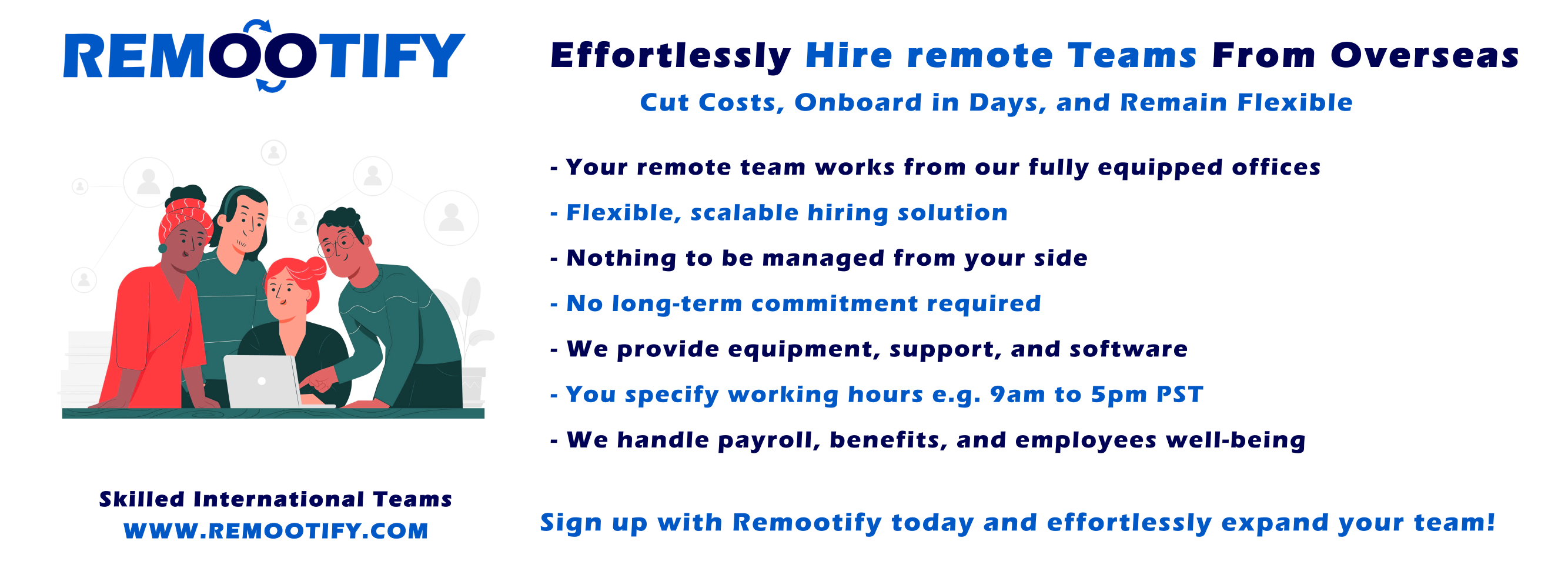Start hiring YOUR REMOTE TEAM, Today!
Enter your information below to start a discussion with one of our team members!

Imagine a bridge that spans the gap between companies and talented software engineers from nearby countries.
That’s nearshore software development: a powerful collaboration model that provides businesses with access to exceptional talent, cost-effective alternatives, and quick reactions to issues.
Learn more about this innovative solution and how it can help you experience the freedom of efficient software engineering.
Key Takeaways
- Nearshore software development offers lower costs without compromising quality.
- It helps overcome talent shortages in the client’s own country.
- Nearshore development provides better communication and delivery outcomes due to closer proximity.
- It allows for personal meetings and clear communication of needs.
What is Nearshore Software Development?
Nearshore software development is a collaboration model that allows you to access tech experts from nearby countries at an affordable price.
With nearshore development, you can benefit from similar quality of development as onshoring but with lower costs and better communication outcomes due to the closer proximity.
It’s the perfect solution for businesses looking for more freedom when it comes to custom software development.
Nearshore development eliminates cultural and geographical barriers, allowing for personal meetings and clear communication of needs.
The same working hours as the customer ensures quick reactions to any issues that may arise during a project.
This reduces travel time and expense for in-person meetings while also fostering stronger collaboration between teams.
In addition, nearshore outsourced services minimize differences in culture, providing IT professionals with result-oriented mindsets who share similar approaches to work which helps build trust between teams even faster.
How Does Nearshore Model Work?
The nearshore model works by outsourcing software development to teams located in nearby countries, offering cost-savings without compromising quality
Nearshoring enables companies to access a pool of tech talent in different parts of the world and select the best candidates for their project needs.
It helps bridge cultural and geographical gaps, allowing for clear communication and quick fixes when needed.
With nearshore software development, developers will have similar working hours as the customer which allows for better coordination and control over the development process.
Nearshoring also minimizes cultural differences between clients and vendors since both parties are in close proximity.
This allows them to share similar approaches to work which facilitates effective communication and understanding, resulting in stronger collaboration and teamwork.
Furthermore, it reduces travel time as well as airfare costs associated with onsite meetings due to closer geographic location.
Features of Nearshore Software Development
It offers better communication and delivery outcomes due to closer proximity, plus cost-effective pricing without sacrificing quality.
Nearshore software development is a cooperation model between a customer and a team of software engineers from nearby countries.
It’s the perfect balance between onshore and offshore models, providing access to top talent at an affordable price.
It helps overcome cultural and geographical barriers while reducing time-consuming air flights for meetings. Plus, it fosters stronger collaboration and teamwork due to similar working hours as the customer.
| Benefits | Challenges |
|---|---|
| Lower costs | Cultural differences |
| Quality experts | Geographical barriers |
| Quick reactions to issues | Language barriers |
| Improved productivity | Time zone differences |
| Stronger collaboration & teamwork |
How to choose right outsourcing model
Deciding which outsourcing model best fits your project needs can be a challenge. To make the right decision, consider the various benefits of each type of outsourcing.
Here’s a breakdown of onshore, offshore, and nearshore software development models to help you choose:
| Comparison | Nearshore | Offshore | Onshore |
|---|---|---|---|
| Focus | 🟢 Collaboration & Cost | 🟢 Cost Savings | 🟢 Local Expertise |
| Time Zones | 🟢 Proximity & Real-time | 🔴 Time Zone Challenges | 🟢 Shared Time Zones |
| Communication | 🟢 High Communication | 🔴 Potential Impact | 🟢 Efficient Communication |
| Cultural Fit | 🟢 Strong Alignment | 🔴 Potential Differences | 🟢 Minimal Differences |
| Cost Structure | 🟢 Balanced Quality & Cost | 🟢 Cost Savings | 🟢 Local Expertise |
| Risk | 🟠 Moderate Risk | 🔴 Potentially Higher Risk | 🟠 Moderate Risk |
| Talent Pool | 🟢 Access to Skilled | 🟢 Diverse Talent Pool | 🟢 Local Professionals |
| Suitable for | 🟢 Real-time Collaboration | 🟢 Various Projects | 🟢 Minimal Cultural Gaps |
| Decision Factors | 🟢 Proximity & Alignment | 🟢 Cost & Complexity | 🟢 Familiarity & Needs |
Nearshoring is increasingly popular due to its combination of cost savings and quality control. It grants access to top talent without sacrificing quality or meeting deadlines.
Plus, it allows for face-to-face meetings when needed. Latin America is an ideal destination for nearshoring due to its rising economies and more affordable labor costs.
A strong cultural alignment also eliminates language barriers and boosts productivity. When used properly, nearshoring is a great way to save time and money while still creating high-quality products that meet customer expectations.
Advantages of Nearshore model
Choosing the right outsourcing model can be daunting, but Nearshore software development offers a solution that is worth considering. With its many advantages, it is quickly becoming a popular option for businesses around the world.
Here are five great reasons why you should consider Nearshore development:
- Cost-Effective: Nearshore development offers great value for money and often comes at a lower cost than Onshore options.
- Time Zone Alignment: Teams in the same time zone as your business make collaboration easier and faster.
- Talent Pool: Access to larger talent pools of experienced developers from nearby countries in Latin America.
- Cultural Alignment: Language and cultural barriers are less pronounced than with Offshore models, making communication smoother.
- Quality Assurance: The close proximity of Nearshore teams allows for better control over the development process.
If you’re looking for an efficient yet cost-effective way to outsource your software projects, then Nearshore may be the perfect choice!
Types of Software Outsourcing
You have three options when outsourcing software projects
- Onshore
- Offshore
- Nearshore
Onshore development hires developers in the same country or region, while offshore development hires vendors in distant countries like China or India.
Nearshore development offers the best of both worlds by fulfilling needs with nearby teams in the same continent. This type of software outsourcing has several advantages that you won’t find with other models.
Nearshore is great for time zone alignment and easy collaboration, allowing you to stay connected with team members without relying on third parties for communication.
Plus, many nearshore companies offer Errors and Omissions Insurance to protect your business from costly mistakes.
Moreover, nearshore developers can provide substantial savings compared to onshoring while still offering top-notch results!
In short, if you’re looking for an affordable way to access quality programming talent without compromising performance or privacy concerns, then nearshoring is worth considering!
With so many benefits at your fingertips – from cost and convenience to trustworthiness – it’s no surprise that more businesses are turning towards this type of software outsourcing model each year.
Nearshore, Onshore and Offshore Software Development Comparison
Comparing onshore, nearshore, and offshore software development can help you determine which model is best for your project.
Onshore development hires tech experts in the same country or region. It’s expensive but offers the potential of face-to-face interaction.
Offshore development hires vendors in distant countries like India or China. It’s the lowest cost option but has its challenges such as language barriers and time zone differences.
Nearshore software development takes advantage of teams in nearby countries with similar cultural settings. This is a more efficient choice that offers:
- Alignment between customer and developer time zones
- Easier collaboration
- Reduced travel costs for in-person meetings
- Faster response to changes or issues
Nearshoring works well for Agile projects, making it ideal for businesses looking to increase velocity while getting more value for their money.
Plus, you don’t have to compromise quality when choosing nearshoring over onshoring since nearshored developers are just as talented.
With its beneficial features and lower costs, nearshore software development could be the perfect fit for your business needs.
Steps to Start With Nearshore Development
To get started with nearshore development, you need to analyze your business needs and determine the required programming languages and frameworks.
Once that’s complete, you can begin to prepare processes and establish mechanisms for online onboarding.
To ensure a successful outcome, provide detailed requirements to the nearshore software development service provider.
Ensure transparent processes and monitoring of hiring mechanisms so that you have full control over the process.
Lastly, make sure all necessary remote tools are at hand in order to enable effective work.
Limitations of Nearshore model
Nearshore Software Development brings several advantages, but also bears limitations:
- Time Zone Constraints: Nearshore teams usually operate within a one- to three-hour time difference, which might not accommodate 24/7 project needs, unlike offshore teams.
- Cultural Nuances: While less pronounced, cultural differences can still affect communication and understanding, occasionally leading to slowdowns.
- Skill Pool Variability: The talent pool in nearshore countries might lack highly specialized skills, impacting projects with unique requirements.
- Proximity Dependency: Relying on proximity might create challenges during disruptions like natural disasters or travel restrictions.
- Cost Considerations: While cost-effective, nearshore options could be costlier than certain offshore choices.
- Staff Turnover Impact: Staff turnover can disrupt project continuity, demanding extra time and resources for onboarding.
- Scalability Hurdles: Quickly scaling nearshore teams could be limited by skilled professionals’ availability.
- Market Competition: Overlapping talent markets in neighboring countries might lead to increased demand, potentially raising costs.
- Regulatory Complexities: Despite similarities, regulatory differences in legal frameworks and data protection need careful navigation.
Frequently Asked Questions
What Are the Most Common Challenges Associated With Nearshore Software Development?
The most common challenges of nearshoring are cultural differences, language barriers, and time zone alignment. Still, with thoughtful collaboration and a shared mission for success, we can overcome the obstacles and reap the rewards of this cost-effective model.
What Type of Projects Are Best Suited for Nearshore Development?
Nearshore development is best suited for projects that require quick response times, smooth communication, and cultural alignment. It’s great for Agile projects, data privacy restrictions, and in-person development.
Are There Any Risks Associated With Nearshore Software Development?
Yes, there are risks associated with nearshore software development. But don’t let that scare you! With the right approach, it can be a great way to get high-quality work done quickly and cost-effectively. So, take the plunge – you won’t regret it!
How Does Nearshore Software Development Compare to Onshore and Offshore?
Nearshore software development offers a balance between onshore and offshore models, with similar quality experts at lower costs. It benefits from closer proximity, cultural alignment, and reduced travel time for meetings.
What Should I Consider When Choosing a Nearshore Software Development Service Provider?
When choosing a nearshore software development service provider, consider their experience, cultural alignment, and cost-effectiveness. Get creative in how you approach the process: look for a partner that’ll help you soar to success!
Conclusion
To sum it up, nearshore software development is a great option for agile projects. This is due to its time zone alignment and easy collaboration.
It offers access to a larger talent pool, better cultural alignment, and language proficiency than offshoring.
Plus, with the right provider like Grid Dynamics, you can have full control over the hiring process. This ensures that your team of developers will deliver quality results on time.
For instance, an airline company was able to double their productivity in just 3 months after moving from offshore to nearshore software development model.
If you’re looking for a reliable outsourcing partner that provides fast solutions without compromising on quality, consider going nearshore!





